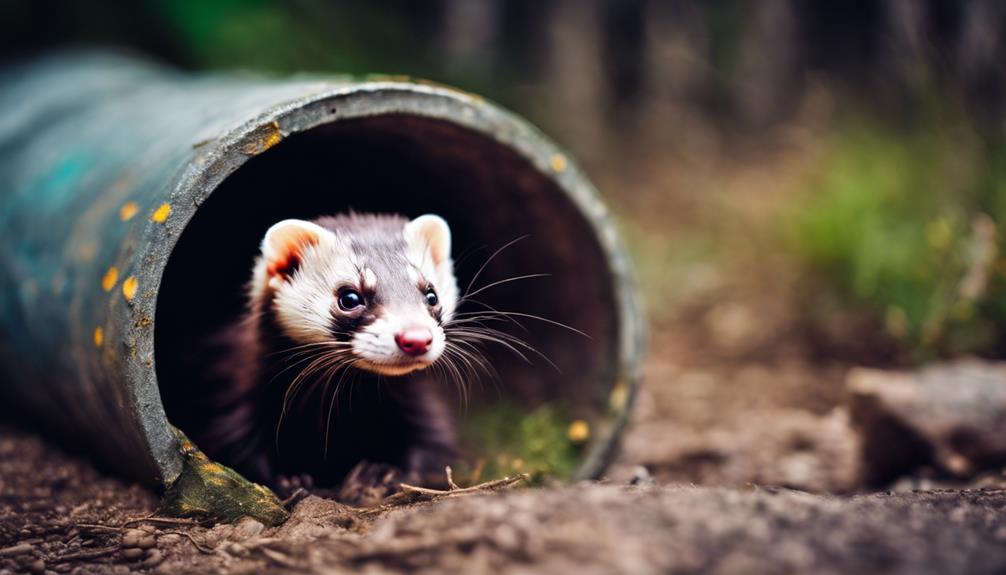When to Replace or Upgrade Ferret Habitat Accessories

When considering whether to replace or upgrade ferret habitat accessories, there are several key factors to keep in mind.
Firstly, the condition of the accessories is crucial. If they show signs of wear and tear, such as fraying ropes or broken parts, it may be time to replace them for the safety and well-being of your ferret.
Additionally, consider the size and suitability of the accessories for your ferret. As your pet grows, their needs may change, requiring larger or more complex accessories to keep them engaged and active.
Lastly, keep in mind the hygiene and cleanliness of the accessories. Regularly cleaning and sanitizing them is essential for your ferret's health and comfort.
By evaluating these factors regularly, you can ensure that your ferret's habitat remains stimulating, safe, and comfortable.
Signs of Wear and Tear
Regularly inspecting ferret habitat accessories is crucial to identify signs of wear and tear before they become safety hazards. Conducting a thorough durability check can help ferret owners determine when it's time to replace or upgrade these accessories. Maintenance tips such as tightening loose screws, repairing torn fabric, or replacing worn-out parts can extend the lifespan of the items. When inspecting, pay attention to frayed edges, rust on metal components, or weak spots in the structure.
In addition to ensuring the safety of the ferrets, maintaining the aesthetic appeal of the habitat is important for many owners. Fortunately, there are budget-friendly options available for replacing or upgrading accessories. Consider DIY solutions like sewing new covers for hammocks or creating homemade toys. Alternatively, explore affordable online stores or local pet shops for a wide range of accessories that cater to both durability and style. By staying proactive and attentive to signs of wear and tear, ferret owners can create a safe and visually appealing environment for their pets.
Safety Concerns

Ensuring the safety of ferrets in their habitat is paramount for responsible pet owners, requiring constant vigilance for potential hazards. When it comes to ferret habitat accessories, hazard prevention and quality assurance are crucial aspects to consider:
- Secure Latches: Always ensure cages and enclosures have secure latches to prevent escapes.
- Smooth Surfaces: Check accessories for any sharp edges or rough surfaces that could cause injuries.
- Non-toxic Materials: Use only non-toxic materials in accessories to prevent poisoning risks.
- Proper Ventilation: Ensure habitats have adequate ventilation to maintain air quality.
- Sturdy Construction: Choose accessories made of durable materials to prevent breakage and potential harm to ferrets.
Lack of Enrichment

To provide a stimulating environment for ferrets, addressing the lack of enrichment in their habitat is essential for their physical and mental well-being. Enrichment alternatives play a crucial role in preventing boredom and ensuring that ferrets remain active and engaged. Without proper stimulation, ferrets may exhibit behaviors such as over-grooming, pacing, or even aggression. To combat this, consider introducing new toys, tunnels, or puzzle feeders to their habitat. These items can provide mental challenges and encourage physical activity, mimicking their natural behaviors in the wild.
In addition to physical enrichment, it's important to offer social interaction and environmental variety. Rotating toys and rearranging their habitat can keep things interesting for ferrets, preventing them from becoming bored with their surroundings. Interactive playtime with their owners or other ferrets can also provide mental stimulation and promote bonding. By incorporating enrichment alternatives and actively focusing on boredom prevention, ferret owners can create a dynamic and engaging environment that supports their pets' overall well-being.
Behavioral Changes

Behavioral changes in ferrets can be indicative of various underlying issues that may require attention and intervention. When observing your ferret's behavior, consider the following:
- Activity Levels: A sudden decrease or increase in activity levels could signal health issues or the need for more environmental stimulation.
- Preferences: Changes in preferences for toys, hiding spots, or sleeping areas may indicate discomfort or boredom.
- Environmental Stimulation: Lack of engagement with toys or surroundings could suggest a need for new interactive accessories.
- Social Interactions: Unusual aggression or withdrawal from social interactions might point towards stress or territorial issues.
- Feeding Habits: Changes in eating patterns, such as overeating or loss of appetite, could indicate health problems or dissatisfaction with their environment.
Size and Fit Issues

Size and fit issues in a ferret's habitat accessories can significantly impact their comfort and overall well-being. Proper sizing is crucial when selecting accessories like hammocks, tunnels, or beds for ferrets. Accessories that are too small can cause discomfort, restrict movement, and lead to stress. On the other hand, items that are too large may not provide the cozy and secure feeling that ferrets crave.
It's essential to choose accessories that offer a comfortable fit, allowing the ferret to move freely and feel safe within its habitat. When considering hammocks or beds, ensure that they're spacious enough for the ferret to stretch out comfortably but snug enough to provide a sense of security. Tunnels should be wide enough for the ferret to move through without feeling cramped. By paying attention to proper sizing and ensuring a comfortable fit, ferret owners can enhance their pets' quality of life and well-being.
Cleaning and Hygiene

Maintaining a clean and hygienic environment for ferrets is essential for their health and well-being. Proper sanitation practices and odor prevention are crucial aspects of ferret care. Here are some tips to ensure a clean habitat:
- Regular Cage Cleaning: Clean the cage thoroughly at least once a week to remove waste and prevent bacterial buildup.
- Wash Bedding and Accessories: Wash bedding, hammocks, and toys regularly with pet-safe detergent to keep them clean and fresh.
- Use Pet-Safe Cleaners: Avoid harsh chemicals when cleaning the cage and accessories to prevent any harm to the ferret's health.
- Provide Fresh Water Daily: Change the water in the water bottle daily to prevent contamination and keep the ferret hydrated.
- Monitor Litter Box: Scoop out the litter box daily and change the litter frequently to maintain cleanliness and control odors.
Upgrading for Variety

When considering upgrading for variety in a ferret habitat, introducing new accessories can provide enrichment and stimulation for your pet. New toys are a great way to keep your ferret engaged and prevent boredom. Look for toys that encourage natural behaviors like digging, tunneling, or hunting. Interactive toys that dispense treats can also provide mental stimulation for your ferret.
Enrichment options such as puzzle feeders or hiding toys around the habitat can promote physical activity and mental engagement. Rotating toys regularly can prevent habituation and keep your ferret interested. Consider adding climbing structures or hammocks to create different levels and areas for exploration.
Additionally, providing different textures like fleece, wood, or cardboard can offer sensory variety for your ferret. Always ensure that any new accessories are safe and appropriate for ferrets to prevent accidents or ingestion of harmful materials. By upgrading your ferret's habitat with new toys and enrichment options, you can enhance their quality of life and overall well-being.
Frequently Asked Questions
Can Ferret Habitat Accessories Be Repaired or Refurbished Instead of Replaced?
When considering ferret habitat accessories, it's essential to assess whether repair or refurbishment is viable before opting for replacement. By maintaining and upgrading items when possible, owners can extend the lifespan of their ferret's habitat.
Are There Any Specific Materials or Brands That Are Recommended for Ferret Accessories to Ensure Longevity?
For ferret habitat accessories, recommended materials such as stainless steel, durable plastics, and washable fabrics are ideal for longevity. Trusted brands like Marshall, Super Pet, and Ware Manufacturing offer quality items that ensure durability and safety for ferrets.
How Often Should Ferret Habitat Accessories Be Rotated or Switched Out for New Ones?
Ferret habitat accessories should be rotated or switched out every 2-4 weeks to keep the environment clean and provide new enrichment. Regular cleaning frequency ensures a healthy and stimulating space for the ferrets.
Are There Any DIY Options for Creating New Enrichment Activities for Ferrets Without Purchasing New Accessories?
For budget-friendly activities, ferret owners can explore DIY enrichment options. Utilizing household items like cardboard boxes, tunnels made from PVC pipes, and old fabric for hammocks can provide new and engaging experiences for their furry friends.
What Are Some Common Mistakes to Avoid When Upgrading Ferret Habitat Accessories for Variety?
When upgrading ferret habitat accessories for variety, one common mistake to avoid is duplicating items. Instead, choose appropriate upgrades that offer new experiences. By doing so, ferrets remain engaged and stimulated, leading to a happier and healthier environment.











